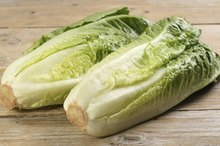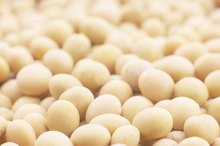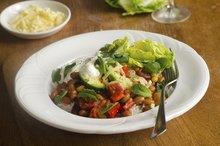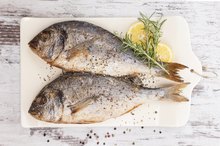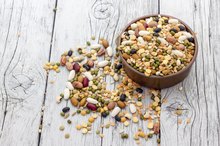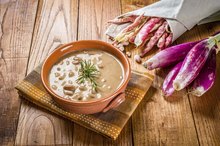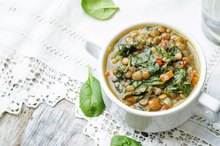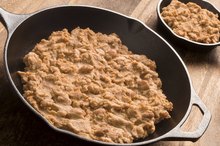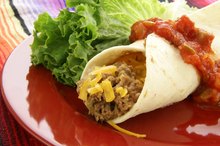Beans & Greens Diet
While there is no specific diet or weight-loss program that focuses predominantly on meals of beans and dark leafy greens, both food types contain such large amounts of nutrients, vitamins, minerals and antioxidants that they are considered to be essential components of a healthy, balanced diet, particularly for vegetarians. Together, beans and greens are inexpensive to purchase, simple to prepare and can help contribute to weight loss and decrease the risk of a number of health conditions.
Beans
Replacing animal proteins high in cholesterol with plant protein derived from beans is linked to lower cholesterol and saturated fat levels and a decreased risk of heart disease and stroke.
Greens
Nutritional Value of Mesclun Greens vs. Romaine Lettuce
Learn More
Vegetables that fall into the category of dark leafy greens include:
- collard greens
- mustard greens
- spinach
- broccoli
- asparagus
- Swiss chard
- cabbage
- Brussels sprouts
These vegetables have no cholesterol and are rich in potassium, folic acid, vitamin A, vitamin E and vitamin C. The Colorado State University extension advises that a healthy diet includes eating one cup cooked or two cups raw leafy green vegetables at least twice a week.
Vegetarian Nutrition
For both strict vegetarians and vegans--individuals who eat no animal products, including no dairy products, eggs and seafood--consuming enough iron can be a major dietary concern. Iron is found abundantly in animal products such as beef or shellfish. However, the Vegetarian Resource Group reports that if vegetarians and vegans make dried beans and leafy green vegetables a staple part of their daily diet, they easily will consume enough iron to prevent anemia, a common iron deficiency condition 1.
Weight Loss
Chick Peas Nutrition Information
Learn More
Beans and dark leafy green vegetables are excellent choices when you are trying to lose weight. According to Peer Trainer, both are low-calorie and low-fat while providing a dense amount of nutrients and, in the case of beans, high-quality protein that contains no cholesterol. Because beans and greens are so nutrient-dense and contain such a large amount of fiber, eating them together in a meal will keep you satisfied--and prevent overeating--longer than eating starchy carbohydrates. The soluble fiber in both beans and greens absorbs water as it is passing through the digestive tract, slowing digestion and making you feel full longer.
- Beans and dark leafy green vegetables are excellent choices when you are trying to lose weight.
- According to Peer Trainer, both are low-calorie and low-fat while providing a dense amount of nutrients and, in the case of beans, high-quality protein that contains no cholesterol.
Cooking Suggestions
Beans and greens are especially good when cooked together in soups and quick sautes. Greens such as collard greens and spinach need to be carefully washed and their tough stems and veins need to be removed. Harder green vegetables, such as broccoli, can be chopped, then lightly steamed. Add them into stir fries with the beans and seasonings like garlic and red pepper, or boil several cups of vegetable broth and add your choice of ingredients into the pot with the vegetables. These dishes make enough for ample leftovers, are cheap and provide excellent nutrition.
- Beans and greens are especially good when cooked together in soups and quick sautes.
Related Articles
References
- The Vegetarian Resource Group: "Iron in the Vegan Diet"; Reed Mangels, Ph.D
- Ellis, E. How to Get Your Kids to Eat Dark Leafy Greens. Academy of Nutrition and Dietetics. Updated February, 2020
- Vitamin K Fact Sheet for Health Professionals. National Institutes of Health Office of Dietary Supplements. Updated February 24, 2020
- Vitamin K. Fact Sheet for Professionals. National Institutes of Health. September 26, 2018
- Di Noia J. Defining Powerhouse Fruits and Vegetables: A Nutrient Density Approach. Prev Chronic Dis 2014;11:130390. DOI: http://dx.doi.org/10.5888/pcd11.130390
- Morris MC, et al. Nutrients and bioactives in green leafy vegetables and cognitive decline. Neurology. 2017 90:e214-e222. doi: 10.1212/WNL.0000000000004815
- O'Sullivan, A., Armstrong, P., Schuster, G. U., Pedersen, T. L., Allayee, H., Stephensen, C. B., & Newman, J. W. (2013). Habitual diets rich in dark-green vegetables are associated with an increased response to ω-3 fatty acid supplementation in Americans of African ancestry. The Journal of nutrition, 144(2), 123–131. doi:10.3945/jn.113.181875
- Pollock R. L. (2016). The effect of green leafy and cruciferous vegetable intake on the incidence of cardiovascular disease: A meta-analysis. JRSM cardiovascular disease, 5, 2048004016661435. doi:10.1177/2048004016661435
Writer Bio
Michelle Kerns writes for a variety of print and online publications and specializes in literature and science topics. She has served as a book columnist since 2008 and is a member of the National Book Critics Circle. Kerns studied English literature and neurology at UC Davis.
